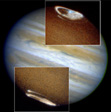|
Links to Aurora-Related Sites |
|
|
|
|
| Cosmic Light Show (http://www.spaceweathercenter.org/our_protective_shield/04/04.html). Historical and scientific information (with images) about auroras. Also be sure to check out the games and activities on this site. | ||
| A Brief Explanation of the Aurora (http://ds9.ssl.berkeley.edu/themis/mission_auroraexplain.html). Aurora information and photos from the THEMIS mission information page. | ||
| Auroras and Comets in 3-D (http://www.astro-photo.com/index.asp). Astro-Photography by Bryan R. | ||
| Steve Irvine's Website (http://www.steveirvine.com/astro). Steve Irvine's aurora photographs. | ||
| Todd Salat's Website (www.aurorahunter.com). Todd Salat website with images and information on the aurora. | ||
| Doug Barnes Gallery of Suroral Images (http://www.fotosearch.com/photos-images/aurora.html). Gallery of auroral images. | ||
| Physics of the Aurora: Earth Systems (http://meted.ucar.edu/hao/aurora/). An interactive learning module about the aurora. This module focuses on the physical systems and processes in the Earth's upper atmosphere and magnetosphere that produce these mysterious lights. | ||
| Auroras on Saturn (http://hubblesite.org/newscenter/newsdesk/archive/releases/2005/06/text/). From hubblesite.org: The dancing light of the auroras on Saturn behaves in ways different from how scientists have thought possible for the last 25 years. New research by a team of astronomers led by John Clarke of Boston University has overturned theories about how Saturn's magnetic field behaves and how its auroras are generated. | ||
| Cool Auroras (http://www.extremeinstability.com/04-11-8.htm). Auroras in Nebraska in November 8, 2004 caused when a Coronal Mass Ejection from the Sun transferred energy to Earth's Magnetic Field, Magnetosphere. | ||
| Aurora and Magnetosphere Tutorial(http://www.meted.ucar.edu/hao/aurora). An excellent tutorial about Earth's magnetosphere and aurora and the physics behind it. | ||
| The Exploratorium's Auroras (http://www.exploratorium.edu/auroras/). For the latest aurora reports and up-to-the-minute ultraviolet images from the Polar spacecraft. The Exploratorium and SECEF | ||
 |
Auroras: Paintings in the Sky (http://www.exploratorium.edu/learning_studio/auroras/) at the Exploratorium. Learn about the Northern Lights on a self-guided tour. Lots of photos and ideas for bringing the Aurora into the classroom. | |
| Last Frontier Footage (http://www.lastfrontierfootage.com/) Real-time video footage of the aurora. | ||
| Marshall Space Flight Center's Space Plasma Physics Branch (http://science.msfc.nasa.gov/ssl/pad/sppb/index_Edu.html) brings you the science behind the aurora and the facts behind its impact on modern technology, such as global telecommunications. | ||
 |
The Jovian Auroras (http://oposite.stsci.edu/pubinfo/pr/96/32.html) The Hubble Space Telescope reveals Jupiter's auroras. | |
| Listening to the Northern Lights (http://www.npr.org/programs/lnfsound/onair/990326.onair.html) The sounds of Natural Radio brings you the work of Steve McGreevy whose recordings of the Earth's magnetic fields durning auroral showers are featured on Lost and Found Sound (http://www.npr.org/programs/lnfsound/). | ||
| The Great Magnet, The Earth (http://istp.gsfc.nasa.gov/earthmag/demagint.htm) Commemorating the 400th anniversary of "De Magnete" by William Gilbert of Colchester, his great study of magnetism which gave the first rational explanation to the mysterious ability of the compass needle to point north-south: the Earth itself was magnetic. | ||
| Sounds of the Magnetoshpere at the University of Iowa (http://listen.to/space-audio) Let this site explain these phonomena as you listen to the sounds of polar plasma events such as whistlers and saucers. | ||
| Solar Max 2000 (http://www-istp.gsfc.nasa.gov/istp/outreach/solarmax/index.html) This site is dedicated to bringing you the latest on magnetic storms that will be reaching Earth as we enter the 23rd solar maximum. | ||
| International Solar-Terrestrial Physics (http://www-istp.gsfc.nasa.gov/) This comprehensive site explores the conncection between the Sun and Earth, including the breathtaking auroral phenomenon. | ||
|
|
The Ozone Hole Tour (http://www.atm.ch.cam.ac.uk/tour/) The Centre for Atmospheric Science at the University of Cambridge explains the devastating impact of the depletion of the Earth's ozone layer over polar regions. | |
| University of Minnesota Space Physics Educational Resources (http://ham.space.umn.edu/spacephys/education.html) This space is currently under development. | ||